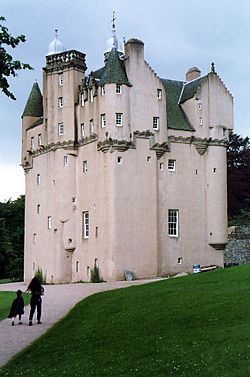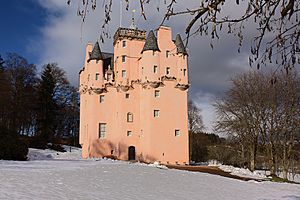Craigievar Castle facts for kids
Quick facts for kids Craigievar Castle |
|
|---|---|
 |
|
| Lua error in Module:Location_map at line 420: attempt to index field 'wikibase' (a nil value). |
Craigievar Castle is a beautiful castle in Aberdeenshire, Scotland. It's about 6 miles south of Alford. This castle is famous for its pinkish color and unique design. For 350 years, the Forbes family lived here. In 1963, they sold it to the National Trust for Scotland, which now looks after it.
Contents
History of Craigievar Castle
This amazing seven-story castle was finished in 1626. It's a great example of the old Scottish Baronial way of building. A rich merchant from Aberdeen named William Forbes built it. He bought the castle when it was only partly built in 1610 from the Mortimer family. He then made sure the building was finished by 1626.
William Forbes was known as "Danzig Willy." This nickname came from his very successful trading business with countries around the Baltic states. He made a lot of money from his travels and sales.
William's son later received a special title from King Charles I. The Forbes family continued to live at Craigievar for many generations. They were good friends with another family, the Clan Burnett of Leys, who built other famous castles like Crathes Castle.
Craigievar Castle is built in an "L-plan" shape, which was common for castles back then. It's especially known for its amazing plasterwork ceilings inside. These ceilings have detailed designs, including figures of the Nine Worthies and symbols of the Forbes family. Many people think Craigievar, Muchalls Castle, and Glamis Castle have the three best plasterwork ceilings in Scotland.
Changes in the 1800s
By the early 1800s, parts of the castle were starting to fall apart. Sir John Forbes, who owned it then, thought about tearing it down. But the city architect, John Smith, told him not to. Smith said the castle was "one of the finest specimens" of its kind. So, they decided to fix it up instead.
Around 1826, they repaired the roof and made other changes. The towers were changed and made taller. They also put in a new entrance door, which was later changed back to the original one. Almost the entire top floor was rebuilt. The windows and the outside plaster (called harling) were also replaced.
The castle used to have more defenses, like a walled courtyard with four round towers. Today, only one of these round towers is left. Inside the archway of this tower, you can still see the carved initials of Sir Thomas Forbes, William Forbes's son. There's also a huge iron gate called a yett that covers the main entrance door.
Some people say that Craigievar Castle is haunted by ghosts!
Craigievar in the 1900s
For some years, the Forbes family lived in a larger house called Fintray House, near Inverurie. During the Second World War, Fintray House was used as a hospital for soldiers from Belgium who were hurt.
In 1963, the Forbes family sold Craigievar Castle and its land to the National Trust for Scotland. This organization now takes care of the castle. Since 1990, the castle has been recognized as a special historic building by the Aberdeenshire Council.
By the late 1970s, the inside of the castle was still very grand. It had a Great Hall with the Stuart family crest above the fireplace. There was also a special gallery for musicians and a secret staircase connecting a high tower to the Great Hall. You could also see the Queen's Bedroom and servants' rooms. Many of the beautiful plasterwork ceilings were still there. The castle also had many portraits of the Forbes family and furniture from the 1600s and 1700s. Two original paintings by Henry Raeburn were also kept there.
Craigievar Castle Today
From 2007 to 2009, the castle was closed for a big renovation. Its outside walls were given a new coat of "harl," which is a traditional plaster. This made the castle look like its original pink color from the 1820s. It reopened to visitors in April 2010. The inside of the castle still has its Great Hall, musicians' gallery, secret staircase, and beautiful plaster ceilings. It also keeps the Forbes family portraits and old furniture.
One special thing about Craigievar Castle is that there has never been any artificial lighting on the upper floors. This means you see the old artworks and furniture in the same natural light as people did centuries ago. The Forbes family wanted the inside of the castle to stay exactly as it was when they lived there, including the lack of electricity for lighting the rooms.
In 2019, a volunteer found what seems to be the castle's original oak door. It was replaced in 1825 and was thought to be lost until then. The door was fixed up and is now on display.
The castle and its surrounding land, which includes over 200 acres of farmland and woods, have been cared for by the National Trust for Scotland for over 60 years. Visitors can usually take guided tours of the castle during the spring and summer months. The grounds are often open all year round. In 2019, over 24,000 people visited the castle. During 2020, the castle was closed due to the COVID-19 pandemic, but the grounds reopened for visitors later that year.
The castle was closed again for about two years for more outside restoration work. The exterior was covered in a special limewash, which is great for protecting the stone walls in Scotland's weather. Craigievar Castle reopened to visitors at the end of May 2024.
Some members of the Forbes family who grew up in the castle before it was given to the National Trust still visit it today. The famous pink color of the castle's exterior was part of the 1826 makeover by architect John Smith. He wanted it to match the color of the granite stone details.
Other sources
- Tranter, Nigel (1966), The Fortified House in Scotland, Volume IV, Oliver & Boyd
See also
 In Spanish: Castillo de Craigievar para niños
In Spanish: Castillo de Craigievar para niños



